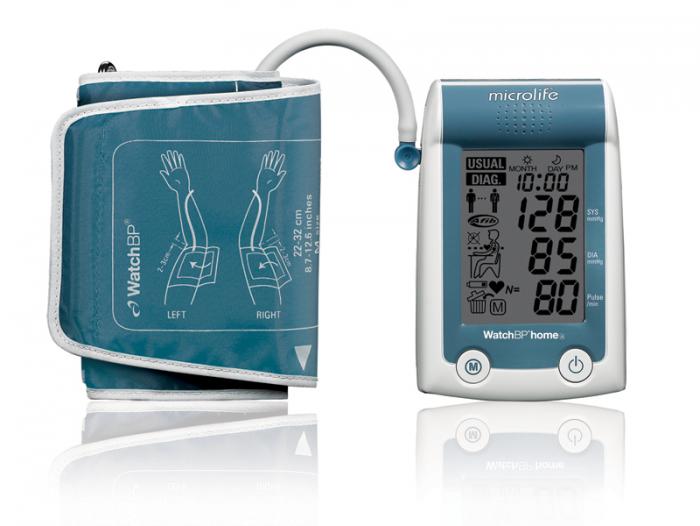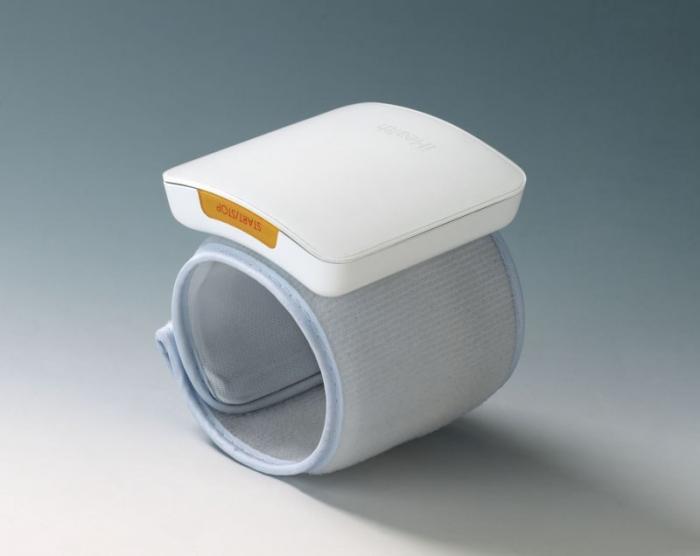Omron BP786
OMRON is one of the most established brands on the home blood pressure (BP) monitor market. And judging by some of the online user reviews of their products, Omron is one of the first names doctors recommend to patients who are considering purchasing their own BP MONITOR, which would seem to justify their "#1 Doctor Recommended Brand" strapline.

Those looking for bells and whistles may be disappointed, but the Omron is a reliable, simple "does what it says on the tin" device.
Image credit: Omron
The company boasts an almost bewildering range of 21 BP MONITORS for sale - the majority of which are for use on the upper arm, although they also offer a small range of wrist-mounted monitors.
Omron kindly sent us their BP786 monitor for review, which is the latest device in their popular "10 series." Currently retailing for less than $80, the BP786 seems to have been slightly less popular so far than its older 10 series siblings.
Although - like most modern home BP MONITORS - the BP786 can hook up to a computer or mobile device, a common complaint in user reviews is that the device appeared to have been "rushed to market," with the apps that allow the monitor to interact with devices not released to customers until some time after the physical product had launched.
Particular problems have been reported with the Android app, although the Omron is fairly unique in offering any Android support at all, with most mobile-friendly monitors integrating only with Apple's iOS platforms (for iPhone, iPad and iPod).
For some customers, though - possibly older customers in particular - one of the strengths of this device may be that you can use the BP786 completely independently of any computerized gadget. It also offers a superbly simple interface - most users are only required to press one big, blue button helpfully labeled "START/STOP."
This no-nonsense approach may sound unappealing to the tech-literate gadget fiends among us but, for MEDICAL MONITORING devices in particular, usability is the cornerstone of good design.
To take a reading, all the user need do is attach the cuff to their upper arm and hit the big, blue button. As well as displaying your BLOOD PRESSURE, the machine will display stats on your pulse and even identify whether you have an irregular heartbeat.
That there is such a shallow learning curve associated with the BP786 is A CREDIT to Omron. Although, I have to confess, it took me a few goes to figure out how to get the machine to take three consecutive readings and provide an average of the results. A design feature I really liked, however, was how easy it is to attach the cuff, which can be done without the assistance of another person.
However, if you do like to take your BLOOD PRESSURE readings with a friend, then Omron have included a neat "two-player" feature, where you can flick between two different sets of readings with one switch, allowing you to compare your readings with one other person. The device can store up to 100 readings per person.
Those looking for bells and whistles may be disappointed - and with a bulky, clunky-looking design, the BP786 cannot compete aesthetically with the sleek, smaller, wearable BP MONITORS - but overall, the OMRON is a reliable, simple "does what it says on the tin" device.
Microlife WatchBP home A
Omron may be the most popular brand with patients, but Microlife would appear to be the most critically acclaimed name in consumer BP MONITORS. Its 3AC1-PC monitor tops Find The Best's comparison chart of BP monitors with an unbeatable 100 out of 100 score, although closer inspection shows that the user rating is a lowly 1.7 out of 5.

Not the sexiest machine ever, but for customers at risk of ATRIAL FIBRILLATION this could be a handy device for monitoring your health in partnership with your doctor.
Image credit: Microlife
Microlife sent us their WatchBP home A monitor to review. Like the Omron machine, the WatchBP home is a standalone device. Although it does not support mobile devices, the WatchBP home does come packaged with its own software that enables the user to analyze their readings on a computer.
Interestingly, this software comes on a 3" CD-ROM, which may feel a little like a "blast from the past" for those of us who have progressed to Macbook Airs or notebook machines, which typically no longer come equipped with CD drives.
While other HOME MONITORS that we looked at offered general BLOOD PRESSURE monitoring, the WatchBP home is more specifically marketed as a device to be used by the patient in conjunction with a physician for detecting atrial fibrillation.
To enable this, the device has two distinct modes: Diagnostic and Usual. The Diagnostic mode should be selected under instruction from a physician as it complies with clinical guidelines for measuring hypertension. In this mode, two sets of blood pressure measurements are taken on 7 consecutive working days.
As the measurements have to be taken at specific times during the day, the device prevents the user from taking a reading outside of the specified times. At the end of the Diagnostic period, the user is then required to take the machine to their doctor for them to analyze the data.
It occurred to us that the Diagnostic mode could provide a solution for patients who experience "white coat syndrome," where BLOOD PRESSURE readings are driven up simply from the effect of being in a doctor's office.
Usual mode, meanwhile, can be used for more ad hoc readings as and when the user requires. One obvious advantage of this mode over that of the OMRON device is the Microlife machine automatically takes three readings in succession (rather than just one) and averages the results, without the user having to fiddle about to find a setting that facilitates this.
Where it compares less favorably to the Omron device is in the arm cuff, which is difficult to self-apply. Both the cuff and device were also considered by the Blog team office to be the least aesthetically pleasing of the available devices, too - featuring a noticeably more "clinical"-looking white and green-blue color scheme.
Not the sexiest machine ever, but for customers at risk of ATRIAL FIBRILLATION, this could be a handy device for monitoring your health in partnership with your doctor.
Microlife spokesperson Edward Gammon also told us that the company is currently working on "devices [that can] can send the data directly into the patient's heath record." He adds that the TECHNOLOGY exists already, but the company are waiting for the market to be ready.
QardioArm Blood Pressure Monitor

A true blood pressure monitor for the iPhone age, everything about this wearable BP MONITOR is elegant and minimal.
Image credit: Qardio
My Blog team was given a complimentary QardioArm monitor at the Wired Health exhibition in London, UK. The QardioArm attracted quite a bit of attention back at the office - a true blood pressure monitor for the iPhone age, everything about this wearable BP MONITOR is elegant and sophisticated, from the packaging to the minimal design of the device itself.
Unlike the Microlife or Omron devices, though, QardioArm cannot be used as a standalone machine and is only compatible with iOS, making it redundant for anyone lacking an iPhone or iPad.
Before they are able to use the monitor, Apple owners are required to first download the Qardio app from either the App Store or the getqardio.com website. And here is where we encountered a problem. Despite a raft of glowing customer testimonials, at the time of writing, we found that not only did the link to the Qardio app not work on the company's own website, but the app was not available at all on the App Store.
Consequently, we have been unable to review this machine. It does look very nice, though.
Developed through an Indiegogo crowdfunding drive, the QardioArm is available to buy commercially at $99.
iHealth Wireless Blood Pressure Monitors
Like QardioArm, the iHealth BP monitors are quite shamelessly marketed at the Apple generation, even going as far as to adopt that notorious lower-case "i" prefix. Again, these machines require an APPLE DEVICE and app to function, and there is no Android support.

The readings from wrist BP monitors are usually higher and less accurate than those taken at the arm, due to the arteries being narrower and not so deep at the wrist.
Image credit: iHealth
However, unlike QardioArm, the iHealth "MyVitals" app was easy to find and install. iHealth sent us two of their devices to review - as well as the standard upper arm-type BP MONITOR, we also received a smaller wrist-mounted device.
The American Heart Association recommend to anyone using a home BP MONITOR that they should use a device that measures the pressure in their upper arm.
The wrist-mounted BP MONITORS are much more sensitive to body position - to get an accurate reading, the user must position their arm and wrist at heart level.
But even if these steps are followed, the readings from wrist BP monitors are usually higher and less accurate than those taken at the arm, due to the arteries being narrower and not so deep at the wrist.
Why go for a wrist BP MONITOR? Some people may have problems taking a BLOOD PRESSUREmeasurement from their upper arm. For instance, they may have a very large arm or find the BP measurements painful.
We noticed a jump in blood pressure readings when comparing the measurements of the iHealth wrist monitor to the upper arm monitor. Helpfully, though, the device has an inbuilt sensor that allows the app to guide the user into angling their arm into the correct position.

For those of you with an aversion to the omnipresent trendiness of Apple, the iHealth is clearly not FOR YOU.
Image CREDIT: iHealth
We found both the devices and app to be very well-designed and user-friendly (although it did crash on the third use). MyVitals supports a variety of iHealth devices, so you can use the app to track not only your BLOOD PRESSURE, but weight, calorie trends, sleep data, physical activity, food intake and more.
It is very easy to manage all aspects of your general HEALTH within the one app, which presents the data in easy-to-understand graphs, comparing the readings to national recommended guidelines, and it also allows users to set their own targets that track performance against them.
The wrist monitor is currently for sale at just over $60, and you can PICK UP the upper arm monitor for just under $90 - excellent value when you consider standalone devices are similarly priced but feature much less functionality.
For those of you with an aversion to the omnipresent trendiness of Apple, the iHealth is clearly not for you. But health-conscious app fans may well want to consider these monitoring products. An advantage of the app-based system may be that UPDATES WILL become available as and when iHealth are ready to roll out bug fixes and additional functionality, without the user having to purchase a new device.
No comments:
Post a Comment